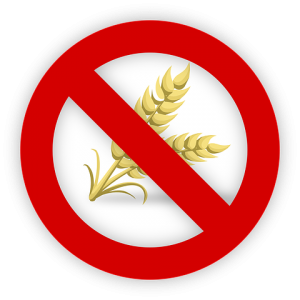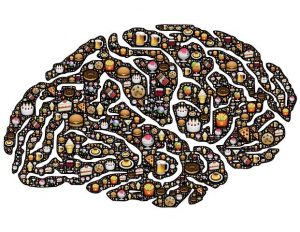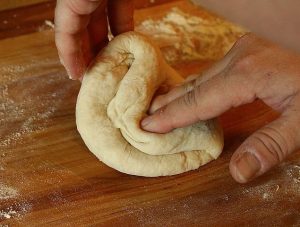The following contains affiliate links.
 Last week’s article covered the myriad reasons not to go gluten-free if you don’t have to. Other than the high cost of specialty gluten-less products, cutting food groups from your diet isn’t healthy. Considering less than 7 percent of Americans have legitimate health issues with gluten, that means the majority of people who’ve jumped on the gluten-haters bandwagon are self-diagnosed. Their reasons for cutting gluten range from being “joiners” who feel the need to go along with everyone else, to “experimenters” who want to give the gluten-free lifestyle a try. When asked why they follow a diet that excludes many foods if they don’t have to, many respond that they felt better after giving up gluten, so they just assumed that it was a smart choice for them. Therein lies the aha moment…
Last week’s article covered the myriad reasons not to go gluten-free if you don’t have to. Other than the high cost of specialty gluten-less products, cutting food groups from your diet isn’t healthy. Considering less than 7 percent of Americans have legitimate health issues with gluten, that means the majority of people who’ve jumped on the gluten-haters bandwagon are self-diagnosed. Their reasons for cutting gluten range from being “joiners” who feel the need to go along with everyone else, to “experimenters” who want to give the gluten-free lifestyle a try. When asked why they follow a diet that excludes many foods if they don’t have to, many respond that they felt better after giving up gluten, so they just assumed that it was a smart choice for them. Therein lies the aha moment…
 In researching the gluten issue, I came across loads of message boards on which people who claimed to be gluten-sensitive all had the same puzzling experience. Though they got headaches, muscle aches, and gastrointestinal distress when eating wheat products here in the U.S., they all gave in to the temptation to indulge in the irresistible crusty breads, fresh pastas, and flaky pastries when vacationing in Europe. To the surprise of the vast majority, these splurges didn’t end up causing the health issues they were used to experiencing back home. Researching the possible cause has resulted in four explanations.
In researching the gluten issue, I came across loads of message boards on which people who claimed to be gluten-sensitive all had the same puzzling experience. Though they got headaches, muscle aches, and gastrointestinal distress when eating wheat products here in the U.S., they all gave in to the temptation to indulge in the irresistible crusty breads, fresh pastas, and flaky pastries when vacationing in Europe. To the surprise of the vast majority, these splurges didn’t end up causing the health issues they were used to experiencing back home. Researching the possible cause has resulted in four explanations.
All Wheat is Not the Same
 First, there are multiple classes of wheat, and five major ones are typically planted in the United States. Of those, hard red winter and hard red spring wheats make up the majority of America’s wheat crops. Those classes were developed to be able to be heartier so they could be planted in off-seasons, allowing wheat to be grown year-round. This small and harmless tweak to wheat genetics increased the gluten content in those hard wheat types. For American bakers, that was seemingly a good thing, as more gluten means softer bread doughs that rise higher. That’s why the two hard red wheat types are used in the majority of bread products produced in the U.S. However, here’s where we come back to the advice we’ve given over and over: most things in moderation are perfectly safe and healthy but in excess, anything, including drinking water, can become dangerous and even deadly. Over years of eating foods with high levels of gluten, it’s no wonder that many people have developed health issues related to it.
First, there are multiple classes of wheat, and five major ones are typically planted in the United States. Of those, hard red winter and hard red spring wheats make up the majority of America’s wheat crops. Those classes were developed to be able to be heartier so they could be planted in off-seasons, allowing wheat to be grown year-round. This small and harmless tweak to wheat genetics increased the gluten content in those hard wheat types. For American bakers, that was seemingly a good thing, as more gluten means softer bread doughs that rise higher. That’s why the two hard red wheat types are used in the majority of bread products produced in the U.S. However, here’s where we come back to the advice we’ve given over and over: most things in moderation are perfectly safe and healthy but in excess, anything, including drinking water, can become dangerous and even deadly. Over years of eating foods with high levels of gluten, it’s no wonder that many people have developed health issues related to it.
What does that have to do with European baked goods? Most of the wheat grown in Europe is soft wheat, so it contains lower levels of gluten. Additionally, many European farmers cultivate heirloom wheat. It’s not the variety that makes this type of wheat special, though heirloom wheat tends to fall into “soft” classifications. Instead, it’s that heirloom wheat hasn’t been tampered with—it hasn’t been engineered or modified to grow in difficult climates or during off-seasons, a factor that has affected gluten levels and, apparently, digestibility.
Whole Wheat Toast, Hold the Pesticide
 Then there’s the toxicity issue. Non-organic wheat in the U.S. is saturated in pesticide before harvest. Yep, the wheat that makes your hot dog buns was drowned in Roundup before it was made into flour. The ingredient in Roundup (glyphosate) that kills insects is supposedly safe for humans and animals. However, studies have found a link between the increased use of glyphosate and an escalation in gastrointestinal disorders. Though dousing wheat crops in Roundup is business as usual in America, many European countries and cities have banned or restricted its use, so the flour made from European wheat, whether it’s heirloom or not, is healthier for eating from the start.
Then there’s the toxicity issue. Non-organic wheat in the U.S. is saturated in pesticide before harvest. Yep, the wheat that makes your hot dog buns was drowned in Roundup before it was made into flour. The ingredient in Roundup (glyphosate) that kills insects is supposedly safe for humans and animals. However, studies have found a link between the increased use of glyphosate and an escalation in gastrointestinal disorders. Though dousing wheat crops in Roundup is business as usual in America, many European countries and cities have banned or restricted its use, so the flour made from European wheat, whether it’s heirloom or not, is healthier for eating from the start.
What’s more, domestic wheat that claims to be pesticide-free isn’t necessarily safe. Part of the genetic engineering U.S. grains have undergone include injecting a gene that produces glyphosate–the exact toxin in Roundup that kills insects. That makes the crops “naturally” resistant to insects, but essentially makes the poison a part of the food that makes it onto your table. Again, although glyphosate supposedly doesn’t affect humans, doctors have found a rise in gastrointestinal issues, such as intestinal permeability, that coincides with the increased use of Roundup.
The Ultra-Processing Piece of the Puzzle

Eating ultra-processed foods has been found to affect your brain’s wiring–literally changing how you react to food, interfering with signals between your stomach and your brain and making you want to eat more and more.
The final piece to the puzzle is that many foods tend to be fresher and undergo less processing in Europe. First, the flours aren’t as processed and don’t contain any additives to extend their shelf-life. What’s more, not only are the flours made from soft wheat that hasn’t been doused in poison, but the breads, pastries, and pastas European flour is used in are made to be consumed immediately. They don’t contain the additives and preservatives that make U.S. wheat products last for a year or more. Don’t think that’s a big deal? Well, considering recent research points to ultra-processing as the real culprit in the obesity epidemic, we should all think again.
A nutrition researcher working for the National Institute of Diabetes and Digestive and Kidney Diseases recently published results of experiments that found that eating highly processed foods interferes with the signals your stomach sends your brain. Essentially, your brain doesn’t get the message that you’re full, so you tend to keep eating. And, other researchers have discovered that eating a lot of ultra-processed foods can end up changing the way your brain is wired, changing your sensitivity and reaction to food. On top of not recognizing that you’re full, you also don’t feel satisfied, so you keep on eating. While those studies may not explain a seeming gluten sensitivity, they do explain why, at least in the United States, bread, pastries, pasta, and other wheat-based, carb-laden foods make you gain weight and make it even harder to take it off.
Also, on a quick aside, ultra-processed foods can cause a spike in blood sugar levels. It’s one of the reasons why people turn against carbs and gluten when they go “keto” or go on other low or no-carb diets. However, European flour made from heirloom wheat and with minimal processing and little to no additives doesn’t interfere with ketosis, so your body can still burn stored fats for energy if you don’t overeat.
A Viable Solution

When you make your own baked goods, you control what ingredients go into them so you know you’re not getting toxins or excessive levels of gluten.
So, what’s a red-blooded American bread-lover to do, especially if you’re not planning on visiting Europe soon? The solution is fairly simple but, like any diet or exercise plan, it takes commitment. First, if you’re not already a label reader, become one now. At the very least, look for organic, non-genetically modified foods when shopping for domestic products. Alternatively, you can buy imported pastas made in Europe. Sometimes you can get them from a local store, but they’re readily available online. Read the label to see that what you’re buying is a product of Italy. The same goes for some cookies and pastries made in Belgium and other European countries. You may find the shelf life isn’t as long as similar American products, but your body will thank you for that.
No, you probably won’t be able to get imported bread, rolls, or pizza dough. This is where the commitment comes in because if you don’t want to give up bagels, bread, muffins, and cake, the best alternative is to make them yourself using Italian flour or other imported flour. It isn’t as cheap is domestic flour, but it’s massively less expensive than gluten-free flour. It will have a much shorter shelf life than that 50-pound bag of hard-wheat flour you got at the grocery warehouse, so just store it in the freezer. The slightly higher price tag is more than worth it for healthier, delicious fresh-baked bread and pastries that your body knows how to process.
Of course, homemade treats also do not last as long as highly-processed baked goods you buy at the store. A loaf of bread may start to taste stale after 3 days and will start to grow mold by day 5 or 6, depending on how humid and warm your house is. The logical solution is making only what your family will consume in a week’s time, but it’s likely that you will have more than you can eat from time to time. Again, your freezer is the answer. Freeze bagels and extra waffles or muffins immediately and put uneaten bread in the freezer by the third day. Baked goods won’t last forever when frozen, but the process cuts down on waste and gives you a chance to eat your healthy homemade food at a more leisurely pace. If you’re tempted to binge-bake and freeze it all, go ahead, but don’t make more than a month’s supply of anything. Helpful hint: bread will dry out if left in the freezer too long, but the texture is perfect for delicious baked French toast.
Try it Yourself
 Even if you’re skeptical, why not try baking with European flour for just a couple of weeks? There’s no comparison for the flavor. Homemade simply tastes better, so you’ll at least appreciate that. But don’t be surprised if eating food made from European flour can satisfy you without making you feel bloated, causing stomach upset, making your joints ache, or causing any of the other effects you may be attributing expressly to gluten. Also, you’ll find the doughs easier to work with. One result of using flour with a lower gluten content is that it isn’t as sticky. That means you won’t need to use much more flour than the recipe calls for when working with bread dough or rolling out pie crusts, rolls, cookies, or pizza crust. In fact, I’ve started home-making pasta again. I’d become frustrated with the pasta dough made from domestic flour getting stuck in my pasta maker but dough made with Italian flour and semolina goes through the machine easily without sticking.
Even if you’re skeptical, why not try baking with European flour for just a couple of weeks? There’s no comparison for the flavor. Homemade simply tastes better, so you’ll at least appreciate that. But don’t be surprised if eating food made from European flour can satisfy you without making you feel bloated, causing stomach upset, making your joints ache, or causing any of the other effects you may be attributing expressly to gluten. Also, you’ll find the doughs easier to work with. One result of using flour with a lower gluten content is that it isn’t as sticky. That means you won’t need to use much more flour than the recipe calls for when working with bread dough or rolling out pie crusts, rolls, cookies, or pizza crust. In fact, I’ve started home-making pasta again. I’d become frustrated with the pasta dough made from domestic flour getting stuck in my pasta maker but dough made with Italian flour and semolina goes through the machine easily without sticking.
Now that you have the facts and first-hand accounts, you can make up your own mind. If you are celiac or have been officially diagnosed with gluten sensitivity, sorry, the solutions outlined here aren’t for you. Any amount of gluten, even if it’s from European wheat, can be dangerous to your health. For others, if your body handles domestic wheat and flour products okay, that’s great. No changes need to be made. On the other hand, if you’ve resorted to avoiding gluten because you suspect it’s affecting your body and health in negative ways, your wish to eat bread, pasta, and cake again may just have been granted.
